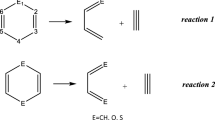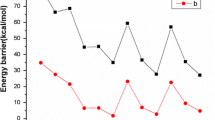Abstract
Enthalpies (Δisom H o(g) ), Gibbs free energies (Δisom G o(g) ), and equilibrium constants (log K isom) for the trans → cis isomerization of various 3,3′-, 4,4′-, and 5,5′- disubstituted 2,2′-diphenoquinones with a range of electron withdrawing and releasing moieties (methyl, fluoro, chloro, bromo, trifluoromethyl, and amino) were calculated in the gas phase and in the solvent phase (n-hexane, benzene, n-octanol, acetonitrile, and water). In the gas phase, the trans isomer of the parent and all substituted 2,2′-diphenoquinones is predicted to be more thermodynamically stable than the cis configuration, with log K isom ranging from −2.8 to −7.0. For all compounds, increasing solvent polarity/proticity progressively favors shifting the cis/trans equilibrium towards greater contributions of the cis configuration and substantially increases the log K isom by up to 5.1 units relative to the gas phase. In polar protic and polar aprotic solvents, the estimated log K isom ranges as low as −0.4, indicating significant populations of the cis isomers should be present. The findings support the polar solvent phase mechanistic predictions for a cis configuration of 2,2′-diphenoquinones participating in the thermal transformation of trans-2,2′-diphenoquinones to oxepino[2,3-b]benzofurans. With limited exceptions for some amino derivatives, the cis-2,2′-diphenoquinone to oxepino[2,3-b]benzofuran isomerization is expected to be thermodynamically favorable for all substituents/phases under consideration. The cis-2,2′-diphenoquinone to oxepino[2,3-b]benzofuran rearrangement is predicted to become less thermodynamically favored with increasing solvent polarity/proticity.


Similar content being viewed by others
References
Hewgill FR, Hewitt DG (1967) Oxidation of alkoxyphenols. Part IX. A dipheno-2,2′-quinone from 2,2′-dihydroxy-5,5′-dimethoxy-4,4′-di-t-butylbiphenyl. J Chem Soc (C) 723–725
Adderley CJR, Hewgill FR (1968) Oxidation of alkoxyphenols. Part XII. The oxidation products of some polymethoxyphenols, and the mechanism of demethylation in neutral solution. J Chem Soc (C) 1434–1438
Bowman DF, Hewgill FR (1971) Oxidation of alkoxyphenols. Part XIX. Base-induced coupling of halogenophenols. J Chem Soc (C) 1777–1788
Hewgill FR (1978) Oxidation of alkoxylphenols—XXIV. Tetrahedron 34:1595–1596
Byrne LT, Hewgill FR, Legge F, Skelton BW, White AH (1982) Oxidation of alkoxyphenols. Part 26. The trimer of a 2, 2′-diphenoquinone (1, 1′-bicyclohexa-3, 5-dienylidene-2, 2′-dione). J Chem Soc Perkin Trans 1:2855–2862
Hewgill FR, Legge F (1982) Oxidation of alkoxyphenols. Part 27. The mechanism of formation of dibenzo[d, f]dioxepins. J Chem Soc Perkin Trans 1:2863–2866
Hewgill FR, La Greca B, Legge F, Roga PE (1983) Oxidation of alkoxyphenols. Part 28. On the configuration of 2, 2′-diphenoquinones. J Chem Soc Perkin Trans 1:131–134
Becker HD, Gustafsson K (1976) On the formation of spiro-substituted benzoxetes by phenol oxidation: preparation and valence isomerization of 3,3′-di-tert-butyl-5,5′-ditrityl-2,2′-diphenoquinone. Tetrahedron Lett 52:4883–4886
Becker HD, Lingnert H (1982) Oxidative conversions of 2,2′-diphenoquinone valence isomers with 2,3-dichloro-5,6-dicyanobenzoquinone. Synthesis and spectroscopic properties of (E)-[3,3′]bibenzofuranylidene-2,2′-diones (isoxindigos). J Org Chem 47:1095–1101
Guan B, Wan P (1993) Photochemistry of dibenzo-1,4-dioxin: formation of 2,2′-biphenylquinone as an observable intermediate. J Chem Soc Chem Commun 409–410
Guan B, Wan P (1994) Photochemistry of dibenzo-1,4-dioxins: intramolecular rearrangement-reduction through observable 2,2′-biphenylquinones. J Photochem Photobiol A 80:199–210
Rayne S, Wan P, Ikonomou MG, Konstantinov AD (2002) Photochemical mass balance of 2,3,7,8-TeCDD in aqueous solution under UV light shows formation of chlorinated dihydroxybiphenyls, phenoxyphenols, and dechlorination products. Environ Sci Technol 36:1995–2002
Rayne S, Sasaki R, Wan P (2005) Photochemical rearrangement of dibenzo[1,4]dioxins proceeds through reactive spirocyclohexadienone and biphenylquinone intermediates. Photochem Photobiol Sci 4:876–886
Hayashi N, Kanda A, Kamoto T, Higuchi H, Akita T (2009) Effect of aryl substituents on intramolecular cyclization of 2,2′-biphenoquinones. Heterocycles 79:865–872
Rayne S (2008) Potential role of 2,2′-biphenylquinones in the carcinogenic/anti-cancer activity of dioxins. Nat Preced. doi:10.1038/npre.2008.1929.1
Frisch MJ, Trucks GW, Schlegel HB, Scuseria GE, Robb MA, Cheeseman JR, Scalmani G, Barone V, Mennucci B, Petersson GA, Nakatsuji H, Caricato M, Li X, Hratchian HP, Izmaylov AF, Bloino J, Zheng G, Sonnenberg JL, Hada M, Ehara M, Toyota K, Fukuda R, Hasegawa J, Ishida M, Nakajima T, Honda Y, Kitao O, Nakai H, Vreven T, Montgomery JA, Peralta JE, Ogliaro F, Bearpark M, Heyd JJ, Brothers E, Kudin KN, Staroverov VN, Kobayashi R, Normand J, Raghavachari K, Rendell A, Burant JC, Iyengar SS, Tomasi J (2009) Gaussian 09, Revision A.02. Gaussian, Inc, Wallingford
Zhao Y, Truhlar D (2008) The M06 suite of density functionals for main group thermochemistry, thermochemical kinetics, noncovalent interactions, excited states, and transition elements: two new functionals and systematic testing of four M06-class functionals and 12 other functionals. Theor Chem Acc 120:215–241
Chai JD, Head-Gordon M (2008) Long-range corrected hybrid density functionals with damped atom-atom dispersion corrections. Phys Chem Chem Phys 10:6615–6620
Tawada Y, Tsuneda T, Yanagisawa S, Yanai T, Hirao K (2004) A long-range-corrected time-dependent density functional theory. J Chem Phys 120:8425–8433
Vydrov OA, Heyd J, Krukau AV, Scuseria GE (2006) Importance of short-range versus long-range Hartree-Fock exchange for the performance of hybrid density functionals. J Chem Phys 125:74106
Vydrov OA, Scuseria GE (2006) Assessment of a long-range corrected hybrid functional. J Chem Phys 125:234109
Vydrov OA, Scuseria GE, Perdew JP (2007) Tests of functionals for systems with fractional electron number. J Chem Phys 126:154109
Grimme S (2006) Semiempirical GGA-type density functional constructed with a long-range dispersion correction. J Comput Chem 27:1787–1799
Becke AD (1988) Density-functional exchange-energy approximation with correct asymptotic behavior. Phys Rev A 38:3098
Lee C, Yang W, Parr RG (1988) Development of the Colle-Salvetti correlation energy formula into a functional of the electron density. Phys Rev B 37:785–789
Miehlich B, Savin A, Stoll H, Preuss H (1989) Results obtained with the correlation energy density functionals of Becke and Lee, Yang and Parr. Chem Phys Lett 157:200–206
Perdew JP (1986) Density-functional approximation for the correlation energy of the inhomogeneous electron gas. Phys Rev B 33:8822–8824
Yanai T, Tew DP, Handy NC (2004) A new hybrid exchange-correlation functional using the Coulomb-attenuating method (CAM-B3LYP). Chem Phys Lett 393:51–57
Perdew JP, Burke K, Ernzerhof M (1996) Generalized gradient approximation made simple. Phys Rev Lett 77:3865–3868
Perdew JP, Burke K, Ernzerhof M (1997) Errata: generalized gradient approximation made simple. Phys Rev Lett 78:1396
Adamo C, Barone V (1999) Toward reliable density functional methods without adjustable parameters: the PBE0 model. J Chem Phys 110:6158–6169
Becke AD (1993) Density-functional thermochemistry. III. The role of exact exchange. J Chem Phys 98:5648–5652
Boese AD, Martin JML (2004) Development of density functionals for thermochemical kinetics. J Chem Phys 121:3405–3416
McLean AD, Chandler GS (1980) Contracted Gaussian basis sets for molecular calculations. I. Second row atoms, Z = 11–18. J Chem Phys 72:5639–5648
Raghavachari K, Binkley JS, Seeger R, Pople JA (1980) Self-consistent molecular orbital methods. 20. Basis set for correlated wave-functions. J Chem Phys 72:650–654
Montgomery JA, Frisch MJ, Ochterski JW, Petersson GA (1999) A complete basis set model chemistry. VI. Use of density functional geometries and frequencies. J Chem Phys 110:2822–2827
Montgomery JA, Frisch MJ, Ochterski JW, Petersson GA (2000) A complete basis set model chemistry. VII. Use of the minimum population localization method. J Chem Phys 112:6532–6542
Curtiss LA, Redfern PC, Raghavachari K (2007) Gaussian-4 theory using reduced order perturbation theory. J Chem Phys 127:124105
Curtiss LA, Redfern PC, Raghavachari K (2007) Gaussian-4 theory. J Chem Phys 126:084108
Marenich AV, Cramer CJ, Truhlar DG (2009) Universal solvation model based on solute electron density and on a continuum model of the solvent defined by the bulk dielectric constant and atomic surface tensions. J Phys Chem B 113:6378–6396
Tomasi J, Mennucci B, Cances E (1999) The IEF version of the PCM solvation method: an overview of a new method addressed to study molecular solutes at the QM ab initio level. J Mol Struct THEOCHEM 464:211–226
Tomasi J, Mennucci B, Cammi R (2005) Quantum mechanical continuum solvation models. Chem Rev 105:2999–3094
Barone V, Cossi M (1998) Quantum calculation of molecular energies and energy gradients in solution by a conductor solvent model. J Phys Chem A 102:1995–2001
Cossi M, Rega N, Scalmani G, Barone V (2003) Energies, structures, and electronic properties of molecules in solution with the C-PCM solvation model. J Comput Chem 24:669–681
Allouche AR (2011) Gabedit: a graphical user interface for computational chemistry softwares. J Comput Chem 32:174–182
Rayne S, Forest K (2010) Gas phase isomerization enthalpies of organic compounds: a semiempirical, density functional theory, and ab initio post-Hartree–Fock theoretical study. J Mol Struct THEOCHEM 948:102–107
Rayne S, Forest K (2010) Performance of the major semiempirical, ab initio, and density functional theory methods in evaluating isomerization enthalpies for linear to branched heptanes. Nat Preced. doi:10.1038/npre.2010.4865.1
Zhao Y, Truhlar DG (2006) A density functional that accounts for medium-range correlation energies in organic chemistry. Org Lett 8:5753–5755
Rayne S, Forest K (2010) Performance of the M062X density functional against the ISOL set of benchmark isomerization energies for large organic molecules. Nat Preced. doi:10.1038/npre.2010.5183.1
Wheeler SE, Houk KN (2010) Integration grid errors for meta-GGA-predicted reaction energies: origin of grid errors for the M06 suite of functionals. J Chem Theory Comput 6:395–404
Huenerbein R, Schirmer B, Moellmann J, Grimme S (2010) Effects of London dispersion on the isomerization reactions of large organic molecules: a density functional benchmark study. Phys Chem Chem Phys 12:6940–6948
Rayne S, Forest K (2010) Theoretical studies on the pKa values of perfluoroalkyl carboxylic acids. J Mol Struct THEOCHEM 949:60–69
Rayne S, Forest K (2010) Accuracy of computational solvation free energies for neutral and ionic compounds: dependence on level of theory and solvent model. Nat Preced. doi:10.1038/npre.2010.4864.1
Rayne S, Forest K (2010) Octanol/water distribution coefficients of the C1 through C7 perfluoro-n-alkyl sulfonates: comparison of the IEFPCM-UFF, CPCM, and SMD solvation models. Nat Preced. doi:10.1038/npre.2010.5103.1
Steiner T (2002) The hydrogen bond in the solid state. Angew Chem Int Ed 41:48–76
Fattahi A, Kass SR, Liebman JF, Matos MAR, Miranda MS, Morais VMF (2005) The enthalpies of formation of o-, m-, and p-benzoquinone: gas-phase ion energetics, combustion calorimetry, and quantum chemical computations combined. J Am Chem Soc 127:6116–6122
Rojas-Aguilar A, Flores-Lara H, Martinez-Herrera M, Ginez-Carbajal F (2004) Thermochemistry of benzoquinones. J Chem Thermodyn 36:453–463
Altarawneh M, Dlugogorski BZ, Kennedy EM, Mackie JC (2010) Thermochemical properties and decomposition pathways of three isomeric semiquinone radicals. J Phys Chem A 114:1098–1108
Saeys M, Reyniers MF, Marin GB, Van Speybroeck V, Waroquier M (2003) Ab initio calculations for hydrocarbons: enthalpy of formation, transition state geometry, and activation energy for radical reactions. J Phys Chem A 107:9147–9159
Van Speybroeck V, Gani R, Meier RJ (2010) The calculation of thermodynamic properties of molecules. Chem Soc Rev 39:1764–1779
Redfern PC, Zapol P, Curtiss LA (2000) Assessment of Gaussian-3 and density functional theories for enthalpies of formation of C1–C16 alkanes. J Phys Chem A 104:5850–5854
Csonka GI, Ruzsinszky A, Tao J, Perdew JP (2005) Energies of organic molecules and atoms in density functional theory. Int J Quant Chem 101:506–511
Curtiss LA, Redfern PC, Raghavachari K (2005) Assessment of Gaussian-3 and density-functional theories on the G3/05 test set of experimental energies. J Chem Phys 123:124107
Roux MV, Temprado M, Chickos JS, Nagano Y (2008) Critically evaluated thermochemical properties of polycyclic aromatic hydrocarbons. J Phys Chem Ref Data 37:1855–1996
Acknowledgments
This study was made possible by the facilities of the Western Canada Research Grid (WestGrid: project 100185), the Shared Hierarchical Academic Research Computing Network (SHARCNET: project sn4612), and Compute/Calcul Canada. We extend sincere thanks to an anonymous reviewer whose suggestions to include calculations on the oxepino[2,3-b]benzofuran systems and the various isodesmic reactions greatly improved the quality of our study.
Author information
Authors and Affiliations
Corresponding author
Electronic supplementary material
Below is the link to the electronic supplementary material.
Rights and permissions
About this article
Cite this article
Rayne, S., Forest, K. Theoretical study of substituent and solvent effects on the thermodynamics for cis/trans isomerization and intramolecular rearrangements of 2,2′-diphenoquinones. Struct Chem 22, 615–625 (2011). https://doi.org/10.1007/s11224-011-9735-x
Received:
Accepted:
Published:
Issue Date:
DOI: https://doi.org/10.1007/s11224-011-9735-x




